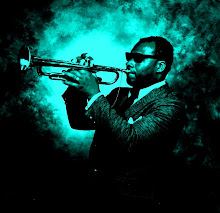

Release date: May 14, 1959
Track List:
1. Feudin' and Fightin'
2. Who You
3. Yesterdays
4. Summer House
5. Anything Goes
6. Indian Love Call
7. Without a Song
8. Linda
9. Falling in Love With Love
10. Opus 116
11. Stompin' at the Savoy
Biography:
Freddie Gambrell could be described as an alternative to Cecil Taylor in terms of extending the legacy of Art Tatum into postmodernism, the majority of his peers choosing to cut and run as if a reader confronted with the first half of this sentence. So much more alluring would be the combination of mysterious and mundane details out of which came his relatively brief time in the spotlight, at least by jazz standards.
Blinded as a teenager, Gambrell mastered enough instruments to humiliate even a multi-instrumentalist from Chicago's Association for the Advancement of Creative Musicians. He learned violin at 11, later recorded on viola, was "introduced" to the public in the early '50s by maestro Chico Hamilton as a pianist in the "blind genius" category, and also played guitar, bass, and brass instruments from top to bottom. One of the strangest things about Gambrell -- which at the very least gives him something in common with Garth Brooks and the suicidal phase of Phil Ochs -- was his reinvention of himself as Federico Cervantes, modern jazz trumpet player.
The discography of Gambrell, such as it is, cannot really be examined without a study of as many as four albums released under the name of the Federico Cervantes Sextet. Reports about these recordings are enthusiastic, mentioning combinations of Latin jazz and country & western and trumpet solos full of the type of daring common to a musician operating under an alias. His approach as Cervantes nonetheless came out of his self-taught background as Gambrell, at one point paying his way by playing keyboards in clubs much more off the beaten track than the San Francisco Jazz Workshop. The latter venue finally provided Gambrell an opportunity to present his keyboard style to a wider, more discerning audience. He was associated with a rhythm section featuring Hamilton and Ben Tucker, a bassist from Nashville.
This artist's stylistic choices under whatever name are bound by their connection to the Bay area, the sweet smell of old vinyl in glossy covers on the World Pacific label perhaps as exciting as the music itself, in parts crystallizing the pianist's Tatum update while jazzing up the score from The Mikado. Critics were of a divided opinion and an alternative viewpoint was available directly from the horse's mouth at The Sticky Wicket, a venue in Santa Cruz where Gambrell began doing a singer/songwriter gig, backing himself on guitar and also opening for himself as a jazz lecturer.
Virtuosity is obviously a great attraction for Gambrell. As Cervantes, he went for the trumpet style of players such as Maynard Ferguson, complete with high-note acrobatics. His emphasis on Tatum, like a violinist choosing Paganini, meant that his keyboard performances were insistently brilliant technically -- although this did not always distract club patrons from watching the seeing-eye dog sitting at Gambrell's feet. ~ Eugene Chadbourne, All Music Guide
SOURCE: answers.com

No comments:
Post a Comment